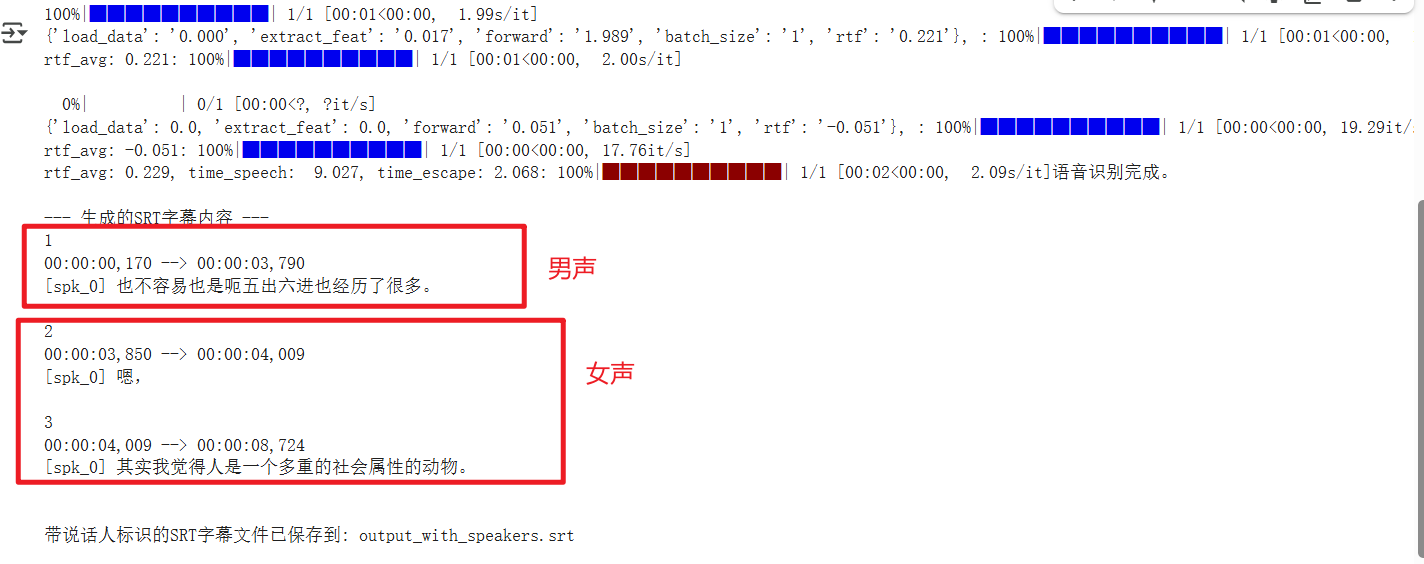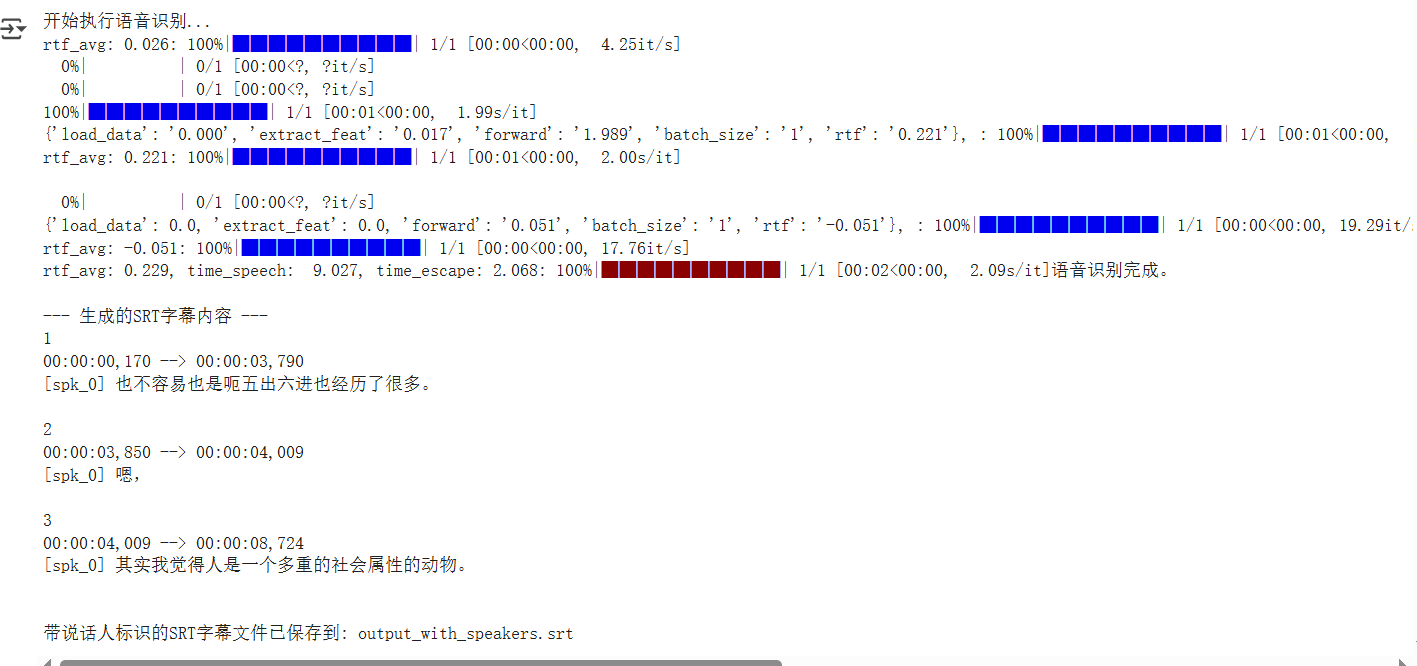Building Speaker-Recognition Subtitles with ModelScope CAM++ and Paraformer: A Complete Journey of Pitfalls and Practice
If you've worked with multimedia content, you know that adding subtitles to videos is a basic task. But if you want to go a step further and automatically label who said each line in the subtitles, the challenge begins.
This article is my complete hands-on record. Starting from a simple idea, I used ModelScope's open-source models to build and debug step by step, ultimately creating a tool that automatically recognizes speakers and generates SRT subtitles. The pitfalls I encountered, the problem-solving approaches, and reflections on technical boundaries during this journey may be more valuable than the final code.
The Initial Blueprint: Two Models, Each with a Role
The goal was clear: input an audio clip of a multi-person conversation and output SRT subtitles with speaker labels like [spk_0], [spk_1].
To achieve this, a single model isn't enough; it requires a combination:
Speaker Diarization
- Task: Identify "who spoke when." It acts like a detective, scanning the entire audio to segment speech by different speakers, but it doesn't care what they said.
- Model Chosen:
iic/speech_campplus_speaker-diarization_common, a battle-tested model in the speaker recognition field. - Model URL: https://www.modelscope.cn/models/iic/speech_campplus_speaker-diarization_common
Automatic Speech Recognition (ASR)
- Task: Handle "what was said." It converts speech signals into timestamped text.
- Model Chosen:
iic/speech_paraformer-large-vad-punc_asr_nat-zh-cn-16k-common-vocab8404-pytorch, the Paraformer model from the FunASR ecosystem, known for its accuracy and efficiency in Chinese recognition. - Model URL: https://www.modelscope.cn/models/iic/speech_paraformer-large-vad-punc_asr_nat-zh-cn-16k-common-vocab8404-pytorch
Result Fusion
- Task: This is our custom "glue" code. It takes the results from the first two steps and, like a director, precisely assigns each line (text + time) to the corresponding actor (speaker), ultimately generating the desired SRT subtitles with speaker labels.
The blueprint was beautiful, but the real challenges emerged when construction began.
The Debugging Journey: Moving Forward Amid "Surprises" and "Unexpected Turns"
The First Hurdle: The "Guessing Game" of API Parameters
Rolling up my sleeves to start, the initial code repeatedly hit walls, with TypeError becoming a common occurrence. The error logs were like impatient guides, repeatedly hinting: "Wrong parameter name!" Through repeated attempts and comparing documentation, I realized that even within the ModelScope ecosystem, different models have different "preferences":
- The speaker diarization
diarization_pipelinerequires the audio parameter namedaudio. - The speech recognition
asr_model.generateinsists oninput.
A small difference in parameter names became the first step of a long journey.
The Second Hurdle: The "Mystery Box" of Model Outputs
I naively assumed the speaker diarization model would politely return a file path in a standard format (like RTTM). However, reality gave a list directly in memory. Even more troublesome, the format of this list changed several times, from an initial "list of lists" to the final minimalist [[start_seconds, end_seconds, speaker_id]] format, which was truly confusing.
This reminded me not to code by assumption; I must print and understand the actual output of the model at every step.
The Third Hurdle: How to Elegantly "Segment Sentences"?
The ASR model gave us a full paragraph of punctuated text and a list of timestamps precise to the "character" level, but it didn't provide ready-made sentence-segmented results. This was another challenge.
Initial Attempt: Clumsy but Effective I manually wrote a
reconstruct_sentences_from_asrfunction, using regular expressions to "brutally" split sentences by punctuation like periods and question marks, then accumulating timestamps based on the word count of each segmented sentence. This method worked but felt un-"AI" and awkward.Final Optimization: Discovering the "Hidden Switch" After in-depth research, I discovered that the FunASR model itself integrates Voice Activity Detection (VAD) functionality, which is inherently designed for sentence segmentation. Simply by adding a
sentence_timestamp=Trueparameter when callingmodel.generate, I could directly obtain a field namedsentence_info. This field contains perfectly segmented sentences with timestamps, achieving the goal in one step.
The Final Confusion: The Code is Correct, Why is the Result Wrong?
When all the code logic was straightened out, I tested it with an audio clip containing clear male and female dialogue, but the result showed all speech coming from the same person. This was the most confusing moment: the code logic was flawless, so why was the result completely off?
 As shown in the runtime result above, the first sentence is male, the second is female, but they were not successfully distinguished.
As shown in the runtime result above, the first sentence is male, the second is female, but they were not successfully distinguished.
I cross-verified with the official example audio and finally confirmed a harsh reality: My code logic was completely correct, but my test audio was too challenging for the cam++ model. Even though I explicitly told the model there were two people present via the oracle_num=2 parameter, it still failed to distinguish them successfully.
The Gap Between Final Code and Reality
This code incorporates all the optimizations mentioned above. It is logically clear and maximizes the use of the models' own capabilities.
import os
import re
from funasr import AutoModel
from modelscope.pipelines import pipeline
from modelscope.utils.constant import Tasks
import soundfile
audio_file = 'he.wav'
try:
data, sample_rate = soundfile.read(audio_file)
if sample_rate != 16000:
print(f"Warning: Audio sample rate is {sample_rate}Hz. For best results, use audio with a 16kHz sample rate.")
except Exception as e:
print(f"Error: Unable to read audio file {audio_file}. Please ensure the file exists and the format is correct. Error: {e}")
exit()
# === Speaker Diarization Model ===
print("Initializing speaker diarization model (cam++)...")
diarization_pipeline = pipeline(
task=Tasks.speaker_diarization,
model='iic/speech_campplus_speaker-diarization_common',
model_revision='v1.0.0'
)
# === Speech Recognition Model ===
print("Initializing speech recognition model (paraformer-zh)...")
asr_model = AutoModel(model="iic/speech_paraformer-large-vad-punc_asr_nat-zh-cn-16k-common-vocab8404-pytorch",
vad_model="fsmn-vad",
punc_model="ct-punc-c")
# --- 2. Execute Model Pipeline ---
print(f"Starting to process audio file: {audio_file}")
print("Starting speaker diarization...")
# If you know the number of speakers, adding this parameter can improve accuracy
num_speakers = 2
diarization_result = diarization_pipeline(audio_file, oracle_num=num_speakers)
diarization_output = diarization_result['text']
print(f"Speaker diarization complete.")
print(f"--- Raw Output from Speaker Diarization Model ---\n{diarization_output}\n---------------------------------")
print("Starting speech recognition...")
# Use the model's built-in VAD for intelligent sentence segmentation, directly obtaining sentence list
res = asr_model.generate(input=audio_file, sentence_timestamp=True)
print("Speech recognition complete.")
# --- 3. Merge and Process ---
def parse_diarization_result(diarization_segments):
"""Parse the [[start, end, id]] format list returned by the speaker diarization model."""
speaker_segments = []
if not isinstance(diarization_segments, list): return []
for segment in diarization_segments:
if isinstance(segment, list) and len(segment) == 3:
try:
start_sec, end_sec = float(segment[0]), float(segment[1])
speaker_id = f"spk_{segment[2]}"
speaker_segments.append({'speaker': speaker_id, 'start': start_sec, 'end': end_sec})
except (ValueError, TypeError) as e: print(f"Warning: Skipping malformed diarization segment: {segment}. Error: {e}")
return speaker_segments
def merge_results(asr_sentences, speaker_segments):
"""Merge ASR results and speaker diarization results"""
merged_sentences = []
if not speaker_segments:
# If speaker diarization fails, mark all sentences as unknown
for sentence in asr_sentences:
sentence['speaker'] = "spk_unknown"
merged_sentences.append(sentence)
return merged_sentences
for sentence in asr_sentences:
sentence_start_sec, sentence_end_sec = sentence['start'] / 1000.0, sentence['end'] / 1000.0
found_speaker, best_overlap = "spk_unknown", 0
# Find the speaker segment with the longest time overlap with the current sentence
for seg in speaker_segments:
overlap_start = max(sentence_start_sec, seg['start'])
overlap_end = min(sentence_end_sec, seg['end'])
overlap_duration = max(0, overlap_end - overlap_start)
if overlap_duration > best_overlap:
best_overlap = overlap_duration
found_speaker = seg['speaker']
sentence['speaker'] = found_speaker
merged_sentences.append(sentence)
return merged_sentences
def format_time(milliseconds):
"""Convert milliseconds to SRT time format (HH:MM:SS,ms)"""
seconds = milliseconds / 1000.0
h = int(seconds // 3600)
m = int((seconds % 3600) // 60)
s = int(seconds % 60)
ms = int((seconds - int(seconds)) * 1000)
return f"{h:02d}:{m:02d}:{s:02d},{ms:03d}"
def to_srt(sentences):
"""Convert merged results to SRT format with speaker IDs"""
srt_content = ""
for i, sentence in enumerate(sentences):
if 'start' not in sentence or 'end' not in sentence: continue
start_time = format_time(sentence['start'])
end_time = format_time(sentence['end'])
speaker_id = sentence.get('speaker', 'spk_unknown')
text = sentence.get('text', '')
srt_content += f"{i + 1}\n{start_time} --> {end_time}\n[{speaker_id}] {text}\n\n"
return srt_content
# --- 4. Generate Final SRT Subtitles ---
speaker_info = parse_diarization_result(diarization_output)
sentence_list = []
if res and 'sentence_info' in res[0]:
sentence_list = res[0]['sentence_info']
else:
print("Error or Warning: Could not retrieve 'sentence_info' from ASR results.")
final_sentences = merge_results(sentence_list, speaker_info)
srt_output = to_srt(final_sentences)
print("\n--- Generated SRT Subtitle Content ---")
if srt_output:
print(srt_output)
output_srt_file = 'output_with_speakers.srt'
with open(output_srt_file, 'w', encoding='utf-8') as f: f.write(srt_output)
print(f"SRT subtitle file with speaker labels saved to: {output_srt_file}")
else:
print("Failed to generate SRT content.")Environment Setup Tips
- Install Dependencies:
pip install -U modelscope funasr addict - Version Compatibility Issues: If errors occur after installation, try downgrading the
numpyanddatasetspackages, which often resolves common compatibility issues:pip install --force-reinstall numpy==1.26.4 datasets==3.0.0
Execution Result on Google Colab
How Far Are Open-Source Speaker Diarization Models from Production Readiness?
This practice proves that it's technically feasible to build a "handcrafted" speaker recognition pipeline. However, this solution also has clear limitations:
The Diarization Model is the Performance Bottleneck: This cannot be overemphasized. The
cam++model is the weak link in the entire workflow. If it fails to "hear" multiple speakers in your audio, no amount of perfect code later can save the day. Its performance is unsatisfactory when handling complex scenarios like background noise, accents, and varying speech rates.Fear of "Overlap" and "Interruption": Our merging logic is "winner takes all" – a sentence is entirely assigned to the speaker with the longest overlap time. It cannot handle complex situations where two people speak simultaneously or dialogue overlaps.
So, looking at the industry, how do other players handle this?
| Solution Type | Representative Tool/Service | Pros | Cons | One-Liner Review |
|---|---|---|---|---|
| Open-Source Integrated Pipeline | WhisperX, Pyannote.audio | Top-tier performance, active community, represents the highest level in academia and open-source. | Complex configuration, high resource consumption, not very user-friendly for beginners. | Suitable for tech experts who love tinkering and pursue ultimate performance; beginners, run. |
| Commercial Cloud Service API | Google STT, AWS Transcribe, iFlyTek | Simple and easy to use, stable and reliable, basically no need to worry about underlying details. | Pay-per-use, high cost, data must be uploaded to the cloud. | The choice for "money power," suitable for rapid development and well-funded enterprises. |
| This Project's Solution | ModelScope + FunASR | Free and open-source, flexible and controllable, models can be freely combined and modified. | Requires hands-on integration and debugging, current performance is unstable. | Suitable for learning, experimentation, and scenarios with low accuracy requirements. |
My initial goal was to test the effectiveness of this solution and, if good enough, integrate it into my other project pyVideoTrans. However, based on actual test results, its performance, especially for long audio, is far from production-ready. And top-tier open-source solutions like Pyannote.audio indeed have deployment and integration complexities that are discouraging.
Therefore, this exploration concludes for now. Although the final product's performance was poor, the entire process remains a valuable learning experience.
